KIA Sportage 2012 SL / 3.G Owner's Guide
Manufacturer: KIA, Model Year: 2012, Model line: Sportage, Model: KIA Sportage 2012 SL / 3.GPages: 387, PDF Size: 8.44 MB
Page 31 of 387
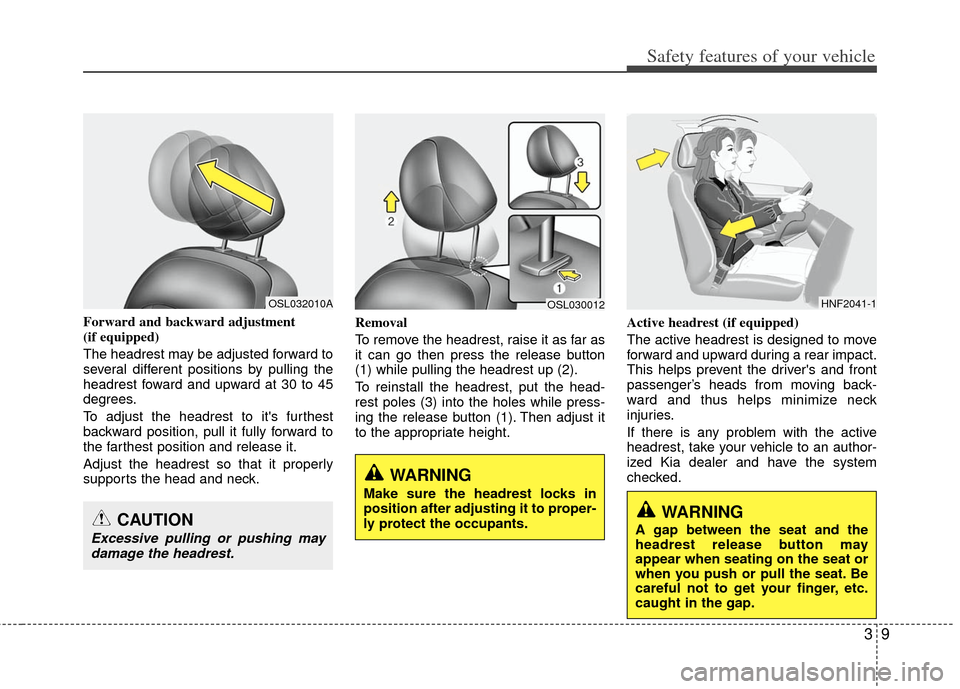
39
Safety features of your vehicle
Forward and backward adjustment
(if equipped)
The headrest may be adjusted forward to
several different positions by pulling the
headrest foward and upward at 30 to 45
degrees.
To adjust the headrest to it's furthest
backward position, pull it fully forward to
the farthest position and release it.
Adjust the headrest so that it properly
supports the head and neck.Removal
To remove the headrest, raise it as far as
it can go then press the release button
(1) while pulling the headrest up (2).
To reinstall the headrest, put the head-
rest poles (3) into the holes while press-
ing the release button (1). Then adjust it
to the appropriate height.
Active headrest (if equipped)
The active headrest is designed to move
forward and upward during a rear impact.
This helps prevent the driver's and front
passenger’s heads from moving back-
ward and thus helps minimize neck
injuries.
If there is any problem with the active
headrest, take your vehicle to an author-
ized Kia dealer and have the system
checked.
CAUTION
Excessive pulling or pushing may
damage the headrest.
WARNING
Make sure the headrest locks in
position after adjusting it to proper-
ly protect the occupants.
HNF2041-1OSL032010AOSL030012
WARNING
A gap between the seat and the
headrest release button may
appear when seating on the seat or
when you push or pull the seat. Be
careful not to get your finger, etc.
caught in the gap.
Page 32 of 387
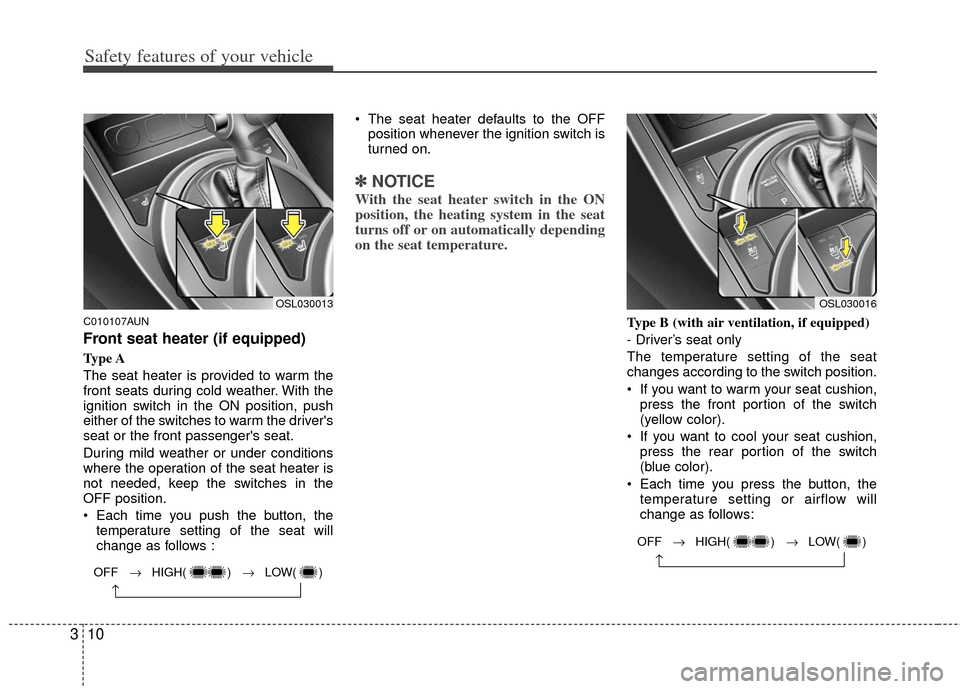
Safety features of your vehicle
10
3
C010107AUN
Front seat heater (if equipped)
Type A
The seat heater is provided to warm the
front seats during cold weather. With the
ignition switch in the ON position, push
either of the switches to warm the driver's
seat or the front passenger's seat.
During mild weather or under conditions
where the operation of the seat heater is
not needed, keep the switches in the
OFF position.
Each time you push the button, the
temperature setting of the seat will
change as follows : The seat heater defaults to the OFF
position whenever the ignition switch is
turned on.
✽ ✽ NOTICE
With the seat heater switch in the ON
position, the heating system in the seat
turns off or on automatically depending
on the seat temperature.
Type B (with air ventilation, if equipped)
- Driver’s seat only
The temperature setting of the seat
changes according to the switch position.
If you want to warm your seat cushion,
press the front portion of the switch
(yellow color).
If you want to cool your seat cushion, press the rear portion of the switch
(blue color).
Each time you press the button, the temperature setting or airflow will
change as follows:
OSL030016
OFF → HIGH( ) → LOW( )
→
OSL030013
OFF → HIGH( ) → LOW( )
→
Page 33 of 387

311
Safety features of your vehicle
The seat heater (with air ventilation)defaults to the OFF position whenever
the ignition switch is turned on.
C010108AAM
Seatback pocket (if equipped)
OCM030052
WARNING- Seatback
pockets
Do not put heavy or sharp objects
in the seatback pockets. In an acci-
dent they could come loose from
the pocket and injure vehicle occu-
pants.
CAUTION
When cleaning the seats, do not use an organic solvent such asthinner, benzene, alcohol and gasoline. Doing so may damagethe surface of the heater or seats.
To prevent overheating the seat heater, do not place anything onthe seats that insulates againstheat, such as blankets, cushionsor seat covers while the seatheater is in operation.
Do not place heavy or sharp objects on seats equipped withseat warmers. Damage to the seatwarming components could occur.
WARNING- Seat heater burns
Passengers should use extreme
caution when using seat heaters
due to the possibility of excess
heating or burns. The seat heater
may cause burns even at low tem-
peratures, especially if used for
long periods of time. In particular,
the driver must exercise extreme
care for the following types of pas-
sengers:
1. Infants, children, elderly or hand-
icapped persons, or hospital out-
patients
2. Persons with sensitive skin or those that burn easily
3. Fatigued individuals
4. Intoxicated individuals
5. Individuals taking medication that can cause drowsiness or
sleepiness (sleeping pills, cold
tablets, etc.)
Page 34 of 387
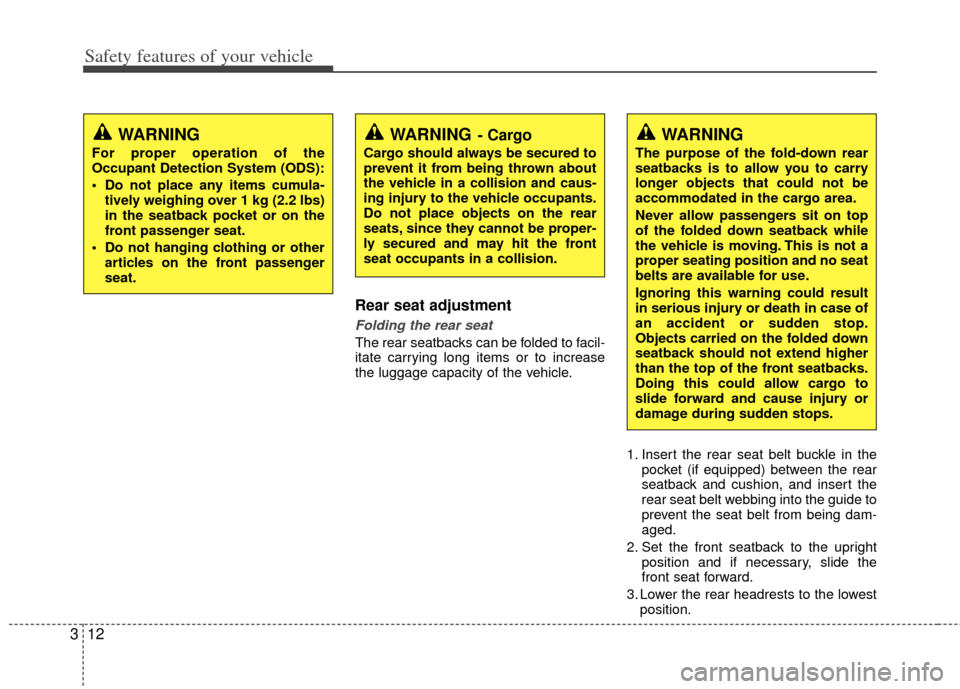
Safety features of your vehicle
12
3
Rear seat adjustment
Folding the rear seat
The rear seatbacks can be folded to facil-
itate carrying long items or to increase
the luggage capacity of the vehicle.
1. Insert the rear seat belt buckle in thepocket (if equipped) between the rear
seatback and cushion, and insert the
rear seat belt webbing into the guide to
prevent the seat belt from being dam-
aged.
2. Set the front seatback to the upright position and if necessary, slide the
front seat forward.
3. Lower the rear headrests to the lowest position.
WARNING
The purpose of the fold-down rear
seatbacks is to allow you to carry
longer objects that could not be
accommodated in the cargo area.
Never allow passengers sit on top
of the folded down seatback while
the vehicle is moving. This is not a
proper seating position and no seat
belts are available for use.
Ignoring this warning could result
in serious injury or death in case of
an accident or sudden stop.
Objects carried on the folded down
seatback should not extend higher
than the top of the front seatbacks.
Doing this could allow cargo to
slide forward and cause injury or
damage during sudden stops.
WARNING
For proper operation of the
Occupant Detection System (ODS):
Do not place any items cumula-tively weighing over 1 kg (2.2 lbs)
in the seatback pocket or on the
front passenger seat.
Do not hanging clothing or other articles on the front passenger
seat.
WARNING- Cargo
Cargo should always be secured to
prevent it from being thrown about
the vehicle in a collision and caus-
ing injury to the vehicle occupants.
Do not place objects on the rear
seats, since they cannot be proper-
ly secured and may hit the front
seat occupants in a collision.
Page 35 of 387
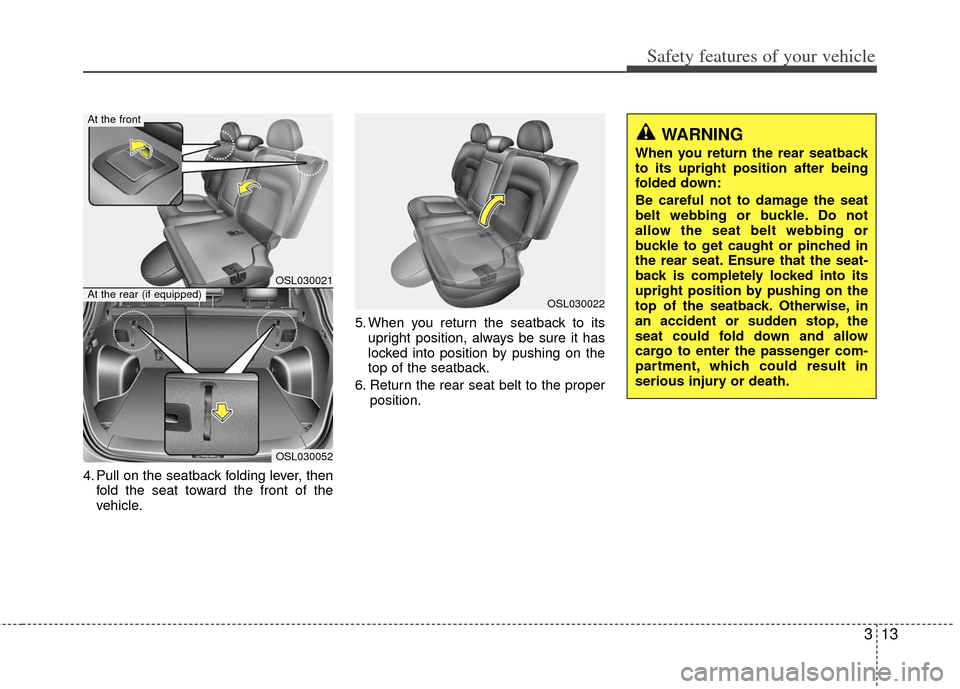
313
Safety features of your vehicle
4. Pull on the seatback folding lever, thenfold the seat toward the front of the
vehicle. 5. When you return the seatback to its
upright position, always be sure it has
locked into position by pushing on the
top of the seatback.
6. Return the rear seat belt to the proper position.
OSL030022
WARNING
When you return the rear seatback
to its upright position after being
folded down:
Be careful not to damage the seat
belt webbing or buckle. Do not
allow the seat belt webbing or
buckle to get caught or pinched in
the rear seat. Ensure that the seat-
back is completely locked into its
upright position by pushing on the
top of the seatback. Otherwise, in
an accident or sudden stop, the
seat could fold down and allow
cargo to enter the passenger com-
partment, which could result in
serious injury or death.
OSL030021
OSL030052
At the front
At the rear (if equipped)
Page 36 of 387
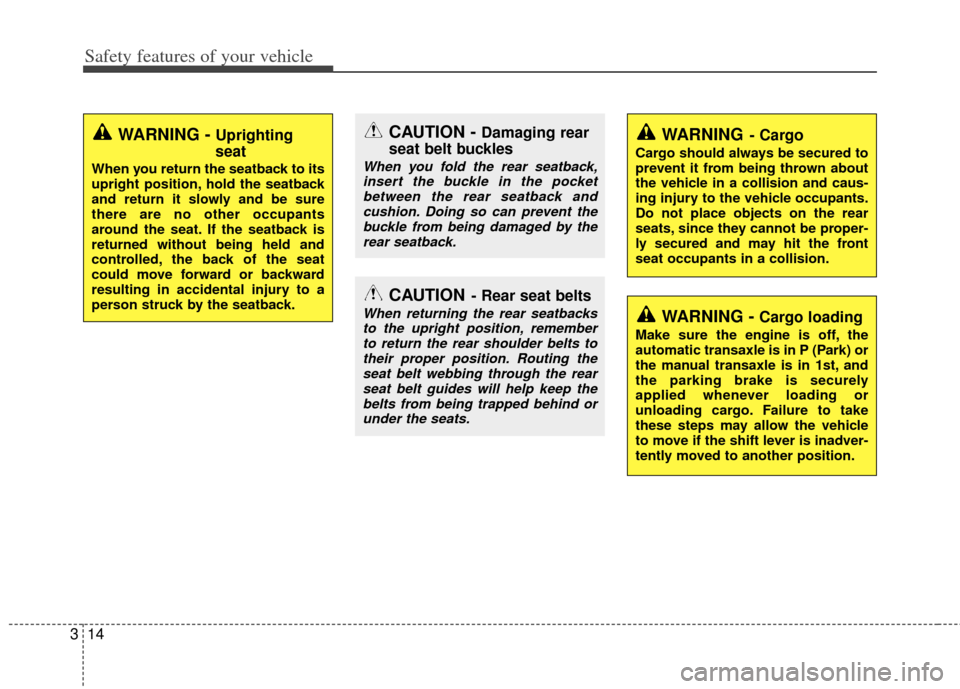
Safety features of your vehicle
14
3
CAUTION- Rear seat belts
When returning the rear seatbacks
to the upright position, remember to return the rear shoulder belts totheir proper position. Routing the seat belt webbing through the rearseat belt guides will help keep thebelts from being trapped behind orunder the seats.
CAUTION - Damaging rear
seat belt buckles
When you fold the rear seatback,
insert the buckle in the pocketbetween the rear seatback andcushion. Doing so can prevent thebuckle from being damaged by the rear seatback.
WARNING - Cargo loading
Make sure the engine is off, the
automatic transaxle is in P (Park) or
the manual transaxle is in 1st, and
the parking brake is securely
applied whenever loading or
unloading cargo. Failure to take
these steps may allow the vehicle
to move if the shift lever is inadver-
tently moved to another position.
WARNING- Cargo
Cargo should always be secured to
prevent it from being thrown about
the vehicle in a collision and caus-
ing injury to the vehicle occupants.
Do not place objects on the rear
seats, since they cannot be proper-
ly secured and may hit the front
seat occupants in a collision.
WARNING - Uprighting
seat
When you return the seatback to its
upright position, hold the seatback
and return it slowly and be sure
there are no other occupants
around the seat. If the seatback is
returned without being held and
controlled, the back of the seat
could move forward or backward
resulting in accidental injury to a
person struck by the seatback.
Page 37 of 387

315
Safety features of your vehicle
C010303AHM
Headrest
The rear seat(s) is equipped with head-
rests in all the seating positions for the
occupant's safety and comfort.
The headrest not only provides comfort
for passengers, but also helps protect the
head and neck in the event of a collision.Adjusting the height up and down
To raise the headrest, push and hold the
release button (1) while pulling it up to
the desired position (2). To lower the
headrest, push and hold the release but-
ton (1) on the headrest support and
lower the headrest to the desired position
(3).
OLM039304N
WARNING
For maximum effectiveness in
case of an accident, the rear seat
headrest should be adjusted so
the middle of the headrest is at
the same height of the center of
gravity of an occupant's head.
Generally, the center of gravity of
most people's head is level to the
height of the top of their eyes.
Also adjust the headrest as close to your head as possible. For this
reason, the use of a cushion that
holds the body away from the
seatback is not recommended.
Do not operate the vehicle with the headrests removed. Severe
injury to an occupant may occur
in the event of an accident.
Headrests may provide protec-
tion against severe neck injuries
when properly adjusted.
After adjusting or reinstalling the headrest, always make sure the
headrest locks in the upright
position to properly protect the
occupants.
OSL030017
Page 38 of 387
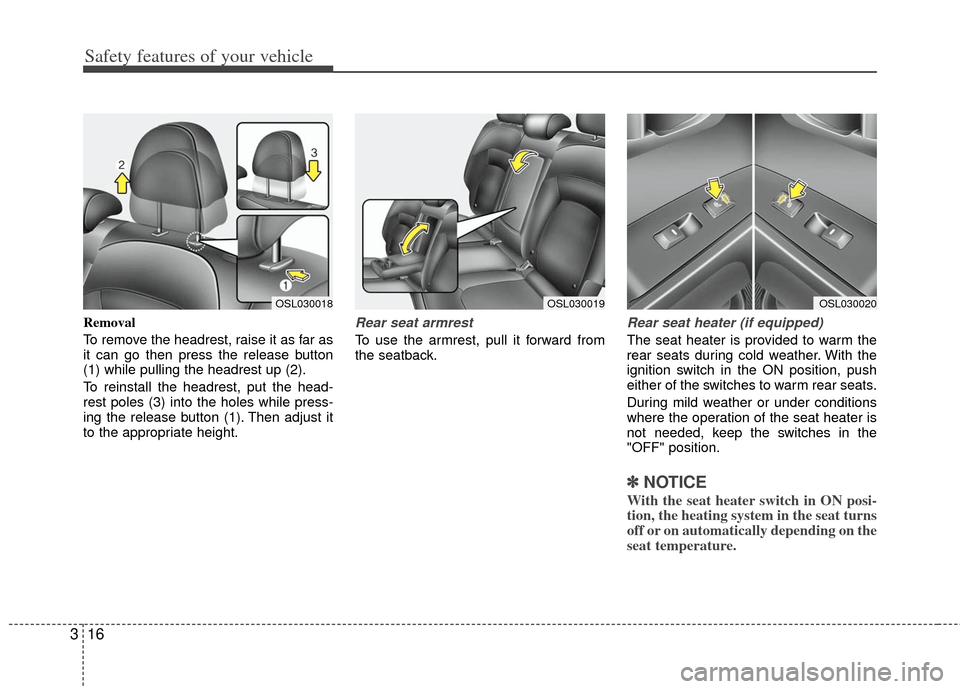
Safety features of your vehicle
16
3
Removal
To remove the headrest, raise it as far as
it can go then press the release button
(1) while pulling the headrest up (2).
To reinstall the headrest, put the head-
rest poles (3) into the holes while press-
ing the release button (1). Then adjust it
to the appropriate height.Rear seat armrest
To use the armrest, pull it forward from
the seatback.
Rear seat heater (if equipped)
The seat heater is provided to warm the
rear seats during cold weather. With the
ignition switch in the ON position, push
either of the switches to warm rear seats.
During mild weather or under conditions
where the operation of the seat heater is
not needed, keep the switches in the
"OFF" position.
✽ ✽
NOTICE
With the seat heater switch in ON posi-
tion, the heating system in the seat turns
off or on automatically depending on the
seat temperature.
OSL030018OSL030019OSL030020
Page 39 of 387
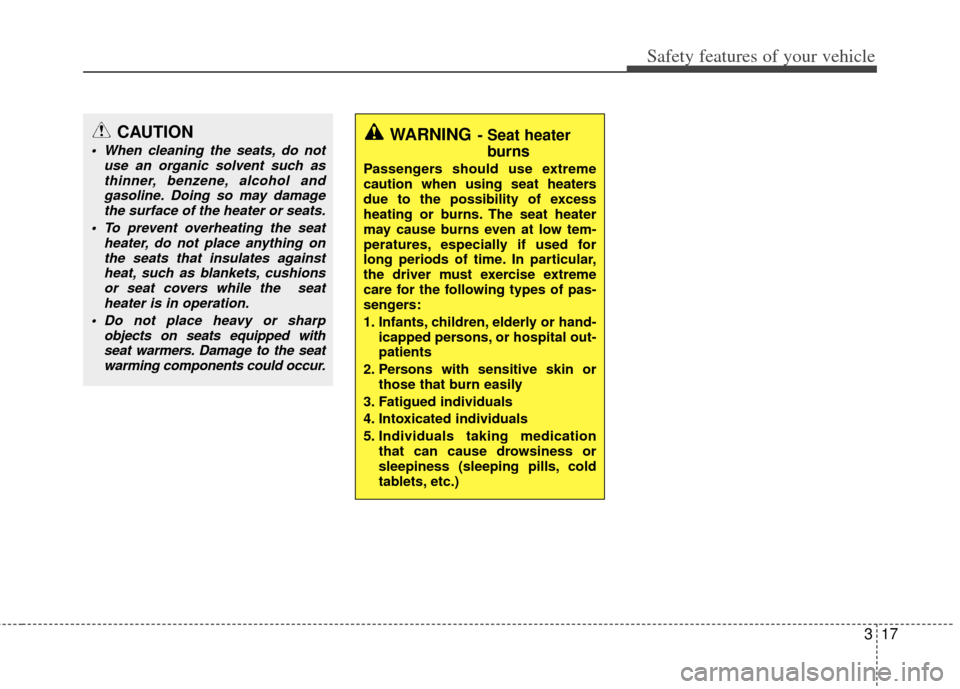
317
Safety features of your vehicle
CAUTION
When cleaning the seats, do notuse an organic solvent such asthinner, benzene, alcohol andgasoline. Doing so may damagethe surface of the heater or seats.
To prevent overheating the seat heater, do not place anything onthe seats that insulates againstheat, such as blankets, cushionsor seat covers while the seatheater is in operation.
Do not place heavy or sharp objects on seats equipped withseat warmers. Damage to the seatwarming components could occur.WARNING- Seat heater burns
Passengers should use extreme
caution when using seat heaters
due to the possibility of excess
heating or burns. The seat heater
may cause burns even at low tem-
peratures, especially if used for
long periods of time. In particular,
the driver must exercise extreme
care for the following types of pas-
sengers:
1. Infants, children, elderly or hand-
icapped persons, or hospital out-
patients
2. Persons with sensitive skin or those that burn easily
3. Fatigued individuals
4. Intoxicated individuals
5. Individuals taking medication that can cause drowsiness or
sleepiness (sleeping pills, cold
tablets, etc.)
Page 40 of 387
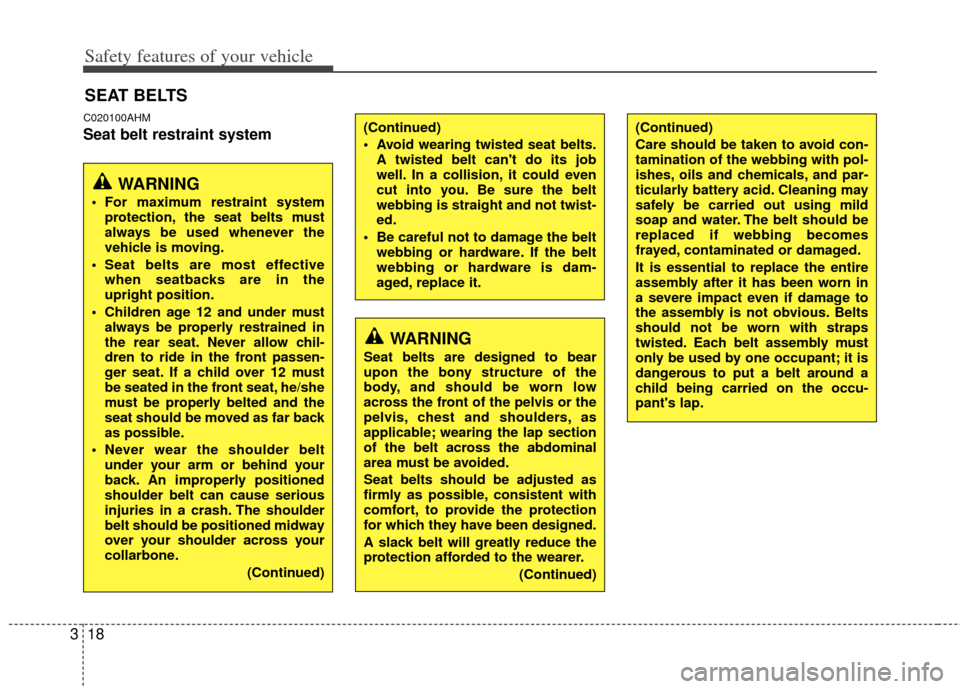
Safety features of your vehicle
18
3
SEAT BELTS
C020100AHM
Seat belt restraint system
WARNING
For maximum restraint system
protection, the seat belts must
always be used whenever the
vehicle is moving.
Seat belts are most effective when seatbacks are in the
upright position.
Children age 12 and under must always be properly restrained in
the rear seat. Never allow chil-
dren to ride in the front passen-
ger seat. If a child over 12 must
be seated in the front seat, he/she
must be properly belted and the
seat should be moved as far back
as possible.
Never wear the shoulder belt under your arm or behind your
back. An improperly positioned
shoulder belt can cause serious
injuries in a crash. The shoulder
belt should be positioned midway
over your shoulder across your
collarbone.
(Continued)
(Continued)
Avoid wearing twisted seat belts.A twisted belt can't do its job
well. In a collision, it could even
cut into you. Be sure the belt
webbing is straight and not twist-
ed.
Be careful not to damage the belt webbing or hardware. If the belt
webbing or hardware is dam-
aged, replace it.(Continued)
Care should be taken to avoid con-
tamination of the webbing with pol-
ishes, oils and chemicals, and par-
ticularly battery acid. Cleaning may
safely be carried out using mild
soap and water. The belt should be
replaced if webbing becomes
frayed, contaminated or damaged.
It is essential to replace the entire
assembly after it has been worn in
a severe impact even if damage to
the assembly is not obvious. Belts
should not be worn with straps
twisted. Each belt assembly must
only be used by one occupant; it is
dangerous to put a belt around a
child being carried on the occu-
pant's lap.
WARNING
Seat belts are designed to bear
upon the bony structure of the
body, and should be worn low
across the front of the pelvis or the
pelvis, chest and shoulders, as
applicable; wearing the lap section
of the belt across the abdominal
area must be avoided.
Seat belts should be adjusted as
firmly as possible, consistent with
comfort, to provide the protection
for which they have been designed.
A slack belt will greatly reduce the
protection afforded to the wearer.
(Continued)